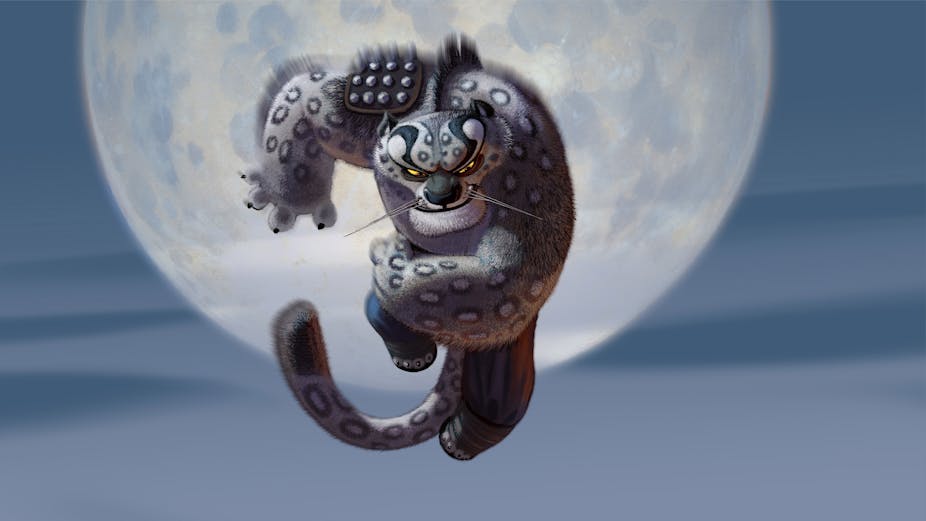When I first started working as an animator on the South Park (1999) feature film in California, I found it remarkable that every Tuesday evening the studio would hold life-drawing classes. It seemed odd that someone who was animating a simple paper cut-out character (albeit a digital simulation of one) would even need to think about drawing, let alone the drawing of realistic human forms.

But to truly understand how figures move (even the most abstracted representations) a good solid understanding of drawing is indispensable. The greater your understanding of the form and construction of a character or object, the better your understanding will be of how it moves.
The DreamWorks Animation exhibition, opening at the Australian Centre for the Moving Image (ACMI), which begins in Melbourne on April 10, features some remarkable examples of pre-production concept art works from a number of the studio’s animated films – including character designs and other concept artwork which will be explored here.
Drawing has always been an important part of animation. Up to 10,000 individual drawings of Walt Disney’s Mickey Mouse and friends (each slightly different in pose) might be drawn in order to produce a seven-minute traditionally animated film.
Many animators will make a habit of sketching the world around them and, when this is not practical, they might find themselves “mentally drawing” their surroundings – “sketching over forms” in their mind and mentally “deconstructing” them.
Today, many animation productions, such as the contemporary 3D animations of Californian film studio DreamWorks, do not usually directly involve sequential drawings to create the animation effect. Yet drawing continues to play a very integral role in the pre-production process – and by extension it hovers over the whole of the production process as well.
Character designs
A character design drawing initially defines the form and look of the character. Will it be a lion with an angular body, or a panda with a very round body?

But these character design drawings go well beyond this in that they also determine to a large extent the personality and attitude of the character; they even help to determine how the character will ultimately move.

Although the character designs at this developmental stage are merely images, they are vessels of potential movement. All sorts of movement cues and possibilities are contained – such as a character’s mass, weight, construction, proportions and balance.
A large unbalanced character, such as Po from Kung Fu Panda (2008), will move quite differently to one that is thinner and more poised, such as Alex the lion in Madagascar (2005).
The drawings also convey a good idea of a character’s temperament, which helps to predict how it might react and move in any given situation.
These character drawings are encoded with all sorts of information that will help the animator understand how the character should move. It could be argued that if the animators also have a good understanding of drawing, they will be very adept at decoding these movement cues.
Environmental concept drawings
Environmental drawings are concept art works that describe the spaces and settings in which the animation will take place. In addition to describing the location and the various components of the scene, they also set the overall tone, colouring, mood and atmosphere.
These drawings communicate to everyone involved in the production what the look and feel of the film will be. In a sense they concretise the original ideas – they bring to a reality what might previously have been merely an idea or some words on a page.

But drawing can be a distinctly exploratory activity. Initially, the artist may have a strong vision of what the scene should look like, but through the process of sketching, working and reworking an image the idea will invariably change and the final image might look quite different.
Many larger animation studios will have a number of artists producing concept artwork and, while each artist will have a very different interpretation of how a scene might look, collectively they will all contribute something of importance to the final film.

Most of these images are indeed conceptual, so they may not refer directly to any particular scene in the movie. Instead they tend to convey more general themes. The dramatic development image above unmistakably communicates the adventurous and mythical qualities that are inherent in much of the How To Train Your Dragon (2010) movie.
Depicting characters within the environmental concept drawings is an important part of the development process. Particularly in 3D animations, characters do not merely perform in front of backdrops, but need to be fully integrated within a space.

In many of these images it is clear that the character can have an effect on the environment, and that the environment has a very profound effect on the character. The above concept image for The Croods (2013) shows the character Grug Crood placed in a rather rugged environment where he undoubtedly faces a rather rugged existence.

By contrast, this second image shows a much gentler environment and indicates a far more pleasant existence for the character Eep Crood.
As the DreamWorks exhibition makes clear, traditional drawings and images still play a very important role in the production of an animated film.
Without conceptual drawings, the animated movie would remain just that: a concept.
DreamWorks Animation: The Exhibition runs from April 10 to October 5 at the Australian Centre for the Moving Image.

